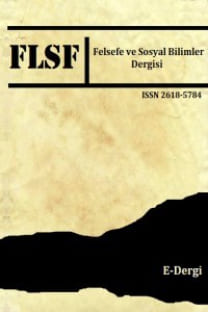ŞEMSEDDİN SAMİ'DEN AHMET NEBİL'E YENİ İNSAN ALGISININ DOĞUŞU
XIX. yüzyıla kadar insana dair genel kabul, insanın Tanrı tarafından yaratılan canlılar arasında bağımsız ve üstün bir tür olduğu ve bu eşsizliğe de diğerlerinde olmayan “akıl” ile sahip olduğudur. Ancak bu algı, başta Lamarck ve Darwin olmak üzere bilim insanlarının eserleriyle ve jeoloji, antropoloji, karşılaştırmalı anatomi ve fizyoloji çalışmalarından elde edilen yeni bilgilerle değişime ve dönüşüme uğramaya başlamıştır ve sonuçta insanın, diğer türlerden maddi ve manevi özellikler bakımından pek bir farkının olmadığı ortaya konulduğu gibi, türlerin değişebildiği ve birbirinden hasıl oldukları da kabul edilmiştir. Öte yandan, insana dair geleneksel algı, Osmanlılarda XIX. yüzyılın son çeyreğine kadar hâkimiyetini sürdürmüştür, bu dönemden itibaren ise Batılı kaynaklardan yararlanarak hazırlanan antropoloji ve jeoloji içerikli eserlerle çağdaş Osmanlı düşünürleri Batı’dakine koşut bir algının yerleşmesine zemin hazırlamışlardır. Bu çalışmada önce Şemseddin Sami’den Ahmed Nebil’e uzanan süreçte, antropoloji alanında Osmanlılarda yayımlanan eserler kısaca tanıtılacak, ardından Osmanlılardaki yeni insan algısının oluşma sürecinin kavranabilmesi amacıyla, bu eserlerde insana ve insanın kökenine dair düşüncelerin İnsanın ne olduğuna, insanın hangi devirde ortaya çıktığına hangi bağlamda ele alındığı tartışılacaktır
Anahtar Kelimeler:
Osmanlılarda Antropoloji, İnsanın Kökeni, Şemseddin Sami, Osman Bey, Mustafa Satı Bey, Ahmed Nebil
THE BIRTH OF THE NEW PERCEPTION OF HUMANKIND FROM ŞEMSEDDIN SAMI TO AHMED NEBIL
The general conviction regarding the humankind up until the 19th century was that human beings were an independent and superior species among all the living beings created by God and this sui generis state was achieved by “reason” which other beings did not possess. This perception, however, began to change and transform through the works of scientists led by Lamarck and Darwin alongside with new data collected by works conducted in geology, anthropology, comparative anatomy, and physiology. Consequently, not only the fact that human beings were no different than other species with regards to material and spiritual characteristics but also the fact that species were able to change and originate from another came to be accepted as well. On the other hand, the traditional perception of humankind maintained its dominance until the last quarter of the 19th century in the Ottoman society but beginning with this era modern Ottoman thinkers paved the way to the establishment of a perception parallel to that of the West by works of anthropology, zoology and geology produced through the utilization of western resources. This study aims to introduce works in anthropology published in the Ottoman era spanning from Şemseddin Sami to Ahmed Nebil and then discuss the ways in which thoughts on humankind and the origin of humankind what the humankind was, which age human beings came into being were dealt with in order to comprehend the process of the new perception of the humankind in the Ottoman society
Keywords:
Anthropology in Ottomans, The Origin of Humankind, Şemseddin Sami, Osman Bey, Mustafa Satı Bey, Ahmed Nebil,
___
- Ahmed Nebil. İnsânın Menşe‘î, İstanbul, 1911.
- Akın, Galip. “Avrupa ve Osmanlı İmparatorluğu’nda İlk Antropolojik Çalışmalar”, Ankara Üniversitesi Dil ve Tarih-Coğrafya Fakültesi Dergisi, XLII, 1-2, 2002, 9-21.
- Akın, Galip. Antropoloji ve Antropoloji Tarihi, Ankara 2011.
- Dayrat, Benoît. “The Roots of Phylogeny: How Did Haeckel Build His Trees?, Systematic Biology, LII, 4 (2003): 515-527.
- Demir, Remzi. Philosophia Ottomanica, 3 Vols, Ankara 2005-2007.
- Demir, Remzi ve Yurtoğlu, Bilal. “Vahdet-i Mevcûd: Bahâ Tevfîk ve Ahmed Nebil’in Haeckel’den Bir Tercümeleri”, Vahdet-i Mevcûd Bir Tabî‘at ‘Aliminin Dîni, translators from Ernst Haeckel: Baha Tevfîk and Ahmed Nebil, Abbreviated and Edited by: Remzi Demir, Bilal Yurtoğlu, Ali Utku, Konya, 2014.
- Haeckel, Ernst. The Last Link, Our Present Knowledge of The Descent of Man. London, 1899.
- Lustig, A. J. “Erich Wasmann, Ernst Haeckel, and the Limits of Science”, Theory in Biosciences, 121 (2002): 252-259.
- Kalaycıoğulları, İnan. “Ahmed Nebil ve İnsânın Menşe‘î”, Dört Öge, Issue 6, Ankara 2014, pp. 89-132.
- Karakoç, İrfan. “Türkiye’de Sosyalist Düşüncenin Az Bilinen Bir İsmi Ahmed Nebil”, Tarih ve Toplum, 191 (1999): 4-8.
- Nicholson, James ve Margetts, Daniel. “Who was… Ernst Haeckel?”, Biologist, LIV, 1 (2007): 32-34.
- Okay, Yeliz. Etnografya’nın Türkiye’ye Girişi ve İlm-i Ahval-i Akvam, İstanbul 2012.
- Özbay, Çiğdem. Mustafa Satı El-Husrî’nin Etnografya Tarihimizdeki Yeri, (Unpublished MA Thesis) Ankara University Institute of Social Sciences, 2014.
- Özbay, Çiğdem, “Mustafa Satı Bey ve Biyoloji Tarihindeki Yeri”, Dört Öge, Issue 8, Ankara 2015, pp. 89-110.
- Özbek, Metin. Dünden Bugüne İnsan, Ankara 2007.
- Özbudun, Sibel. “Anthropology as a nation-building rhetoric: the shaping of Turkish anthropology (from 1850s to 1940s)”, Dialectical Anthropology, Volume 35, 1, pp. 111-129.
- Potts, George D. “Ernst Haeckel: A Biographical Sketch”, The American Biology Teacher, XXXVIII, 9 (1976): 544-545+556.
- Sedgwick, Adam (Ed.). Proceedings of the Fourth International Congress of Zoology, London 1899.
- Şemseddin Sami. İnsan, Ed. Galip Akın, Ankara 1998.
- Şemseddin Sami. Yine İnsan, Ed. and Foreword by Galip Akın, Ankara 1999.
- Toprak, Zafer. Darwin’den Dersim’e Cumhuriyet ve Antropoloji, İstanbul 2012.
- Toprak, Zafer. Türkiye’de Popülizm 1908-1923, İstanbul 2013.
- Yayın Aralığı: Yılda 2 Sayı
- Başlangıç: 2006
- Yayıncı: Hamdi BRAVO
